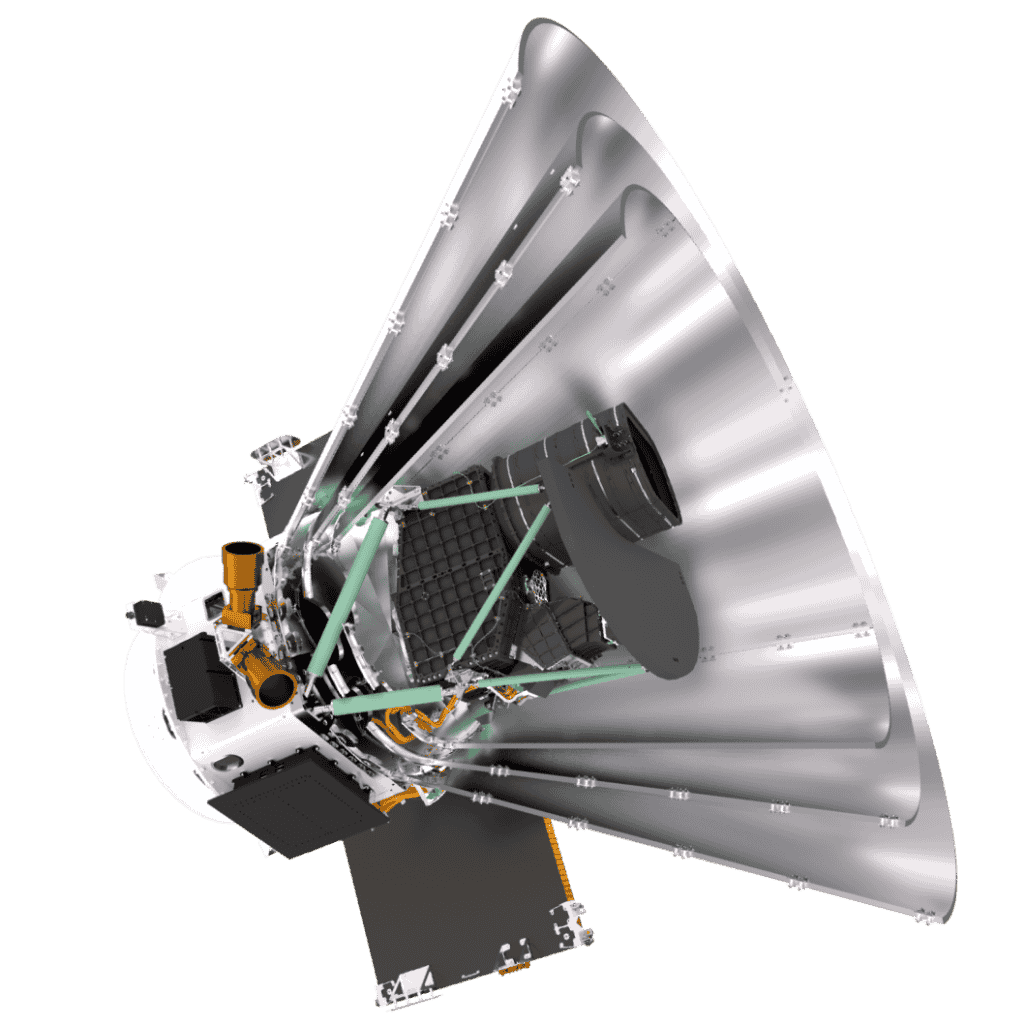SPHEREx
All-Sky Spectroscopist
Infrared telescope mapping the entire sky

USPs
- Maps the entire sky every six months using infrared spectroscopy
- Studies galaxy formation, large-scale cosmic structure, and the history of cosmic expansion
- Analyzes molecular ices in star-forming regions, shedding light on planetary system formation
- Performs an all-sky spectral survey in 102 color bands, from 0.75 to 5 microns
- Collects approximately 3,600 spectra-rich images per day
- Provides a legacy data set for future missions like JWST and Roman
- Measures redshifts for hundreds of millions of galaxies to trace cosmic structure
- Operates from a sun-synchronous orbit to enable consistent lighting and thermal conditions
Major Milestones
- 2014-12-19: Proposal submitted to NASA for the Small Explorer program, initiating the development of the SPHEREx mission.
- 2015-07-30: Selected for Phase A conceptual development under the Small Explorer program, marking the start of detailed planning.
- 2016-07-19: Submitted detailed concept study report to NASA, though not selected for the Small Explorer program.
- 2016-12-15: Enhanced proposal submitted as a Medium-Class Explorer mission, advancing to the finalist stage.
- 2019-02: Selected as the winner of the Medium-Class Explorer competition, approving construction and launch preparations.
- 2021-01-07: Entered Phase C, with early design plans approved and teams beginning final design and hardware assembly.
- 2025-03-12: Launched aboard a SpaceX Falcon 9 rocket from Vandenberg Space Force Base, initiating its two-year all-sky survey mission.
- 2025-03-18: Ejected dust cover, marking the telescope's first 'opening of its eyes' to begin observations.
- 2025-05-02: Began its science mission after six weeks of preparation, capturing approximately 3,600 images per day.
- 2025-07-17: Ongoing mission operations, mapping the sky in 102 color bands to explore cosmic origins and galactic ices.
Cosmic Portrait
SPHEREx: Mapping the Infrared Sky
SPHEREx (Spectro-Photometer for the History of the Universe, Epoch of Reionization and Ices Explorer) is a groundbreaking NASA space telescope launched in March 2025. It’s designed to perform a full-sky survey in the infrared spectrum every six months, opening new windows into the early universe, galaxy formation, and the role of molecular ices in star and planet development. As part of NASA’s Medium-Class Explorers program, SPHEREx aims to unlock answers to fundamental astrophysical questions.
- Science Objectives: SPHEREx will collect spectral data on over 450 million galaxies and map water and organic ices in the Milky Way, enabling astronomers to trace the building blocks of life.
- Orbit & Coverage: Operating in a sun-synchronous polar orbit, the telescope can scan 99.9% of the sky in every cycle, ensuring global infrared coverage with minimal shadowing.
- Spectral Technology: Equipped with near-infrared detectors and a compact optical design, SPHEREx can observe wavelengths from 0.75 to 5 microns, capturing subtle signals from the distant cosmos.
- Budget & Design: With a cost-effective mission profile of $488 million, SPHEREx demonstrates how advanced science can be delivered through efficient engineering and miniaturized systems.
The Scientific Impact of SPHEREx
SPHEREx is not just a telescope—it's a time machine. By analyzing the redshifted light of distant galaxies, SPHEREx will provide a 3D map of the universe, shedding light on how dark energy affects cosmic expansion. The mission also helps pinpoint the era of reionization—a key period when the first stars and galaxies illuminated the cosmos.
SPHEREx's infrared sky atlas will be a treasure trove for the global scientific community. Its legacy dataset is expected to complement upcoming missions like JWST, Euclid, and Roman Space Telescope, offering deep context to their narrow-field observations.
Why SPHEREx Matters
SPHEREx is painting a 3D portrait of the cosmos, from the Big Bang to today—capturing the invisible patterns of light that shaped everything we see.
Whether you're studying the early universe, tracing star formation, or decoding planetary origins, SPHEREx offers unparalleled data for understanding our place in the cosmos.
Fun Fact
SPHEREx will create a 3D map of the universe’s galaxies!